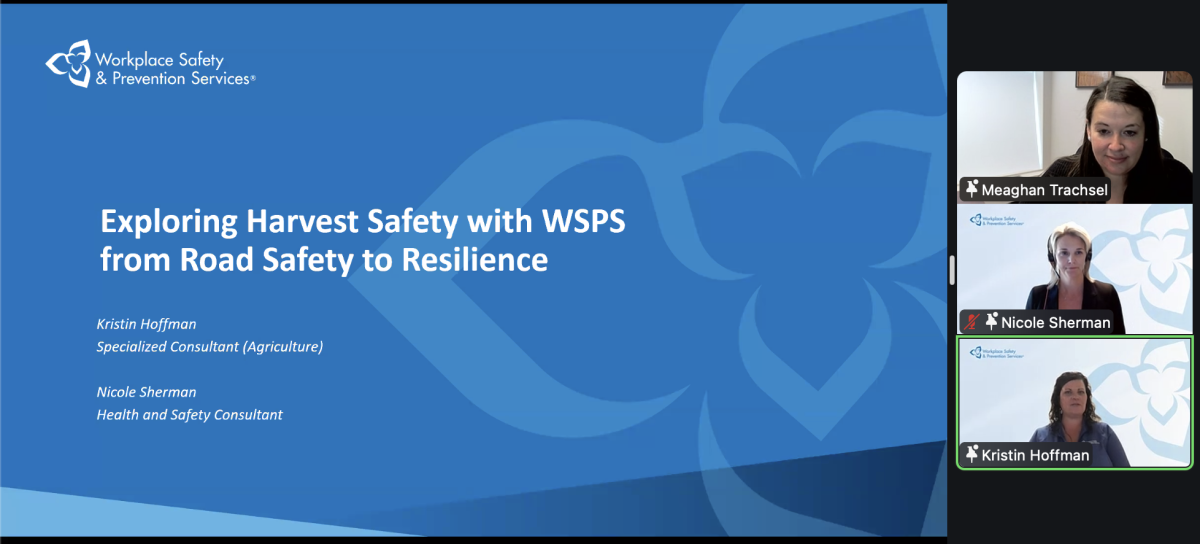Consumers by now are used to seeing a range of organic fruits and vegetables for sale in their local grocery store, but the most common certified organic product reported by Canadian farmers is probably not what they think.
In fact, the most commonly reported certified organic class consists of field crops and hay, according to a new study published Friday in the online version of Canadian Agriculture at a Glance. The study analyzed the evolution in the organic farming sector in Canada between 2001 and 2006.
Read Also

Exploring Harvest Safety
Kristin Hoffman of WSPS explains measures for increased farm safety around harvest season
The study, based primarily on data from the 2006 Census of Agriculture, showed that 2,462 farming operations reported growing certified organic field crops and hay, nearly half of them in Saskatchewan.
Canada has a competitive advantage for growing grains and oilseeds because of the climate and large expanses of cropland suited to mechanization. So it makes sense that organic field crops and hay would be the most common certified organic product.
Many of the field crops grown organically are sold internationally — not processed, sold or eaten in Canada.
In 2006, the Organic Agriculture Centre of Canada oversaw a study on sales of certified organic products through traditional mainstream supermarkets. It found that in spite of impressive growth, sales of certified organic products accounted for less than one per cent of the $46.5 billion Canadians spent in national grocery stores in 2006.
Increase in number of certified organic farms
The 2006 Census of Agriculture questionnaire asked farmers whether their products were certified by an organic certifying agency, whether they were organic, but not certified, or whether they were in transition to becoming certified.
Farms producing organic but not certified commodities outnumbered both certified organic farms and farms that are in transition to becoming certified.
In 2006, 11,937 farms reported producing organic but not certified agricultural products.
Additionally, 3,555 farms reported growing certified organic products, an increase of nearly 60 per cent from 2,230 in 2001, while 640 farms were in transition.
Combined, farms in Quebec and Saskatchewan accounted for over half of the large increase in farms growing certified products.
Despite the large gain, the farm operations growing certified organic products represented only 1.5 per cent of all farm operations.
Saskatchewan reported the most farms growing certified organic products (1,181), as it did in 2001. Quebec placed second with 765 farms reporting. Saskatchewan also had the greatest increase in the number of such farms, while Quebec had the second largest increase.
While Canada has had national organic standards since 1999, these have been voluntary. As such, standards applied by individual certification bodies were subject to variation.
Federal regulations for organic products, the Organic Products Regulations, are scheduled to take effect on Dec. 14, 2008. On this date, organic products marketed interprovincially or internationally must be certified by a certification body accredited by the Canadian Food Inspection Agency.
Fruits and vegetables second most common certified organic products
A significant number of certified organic operations, 916, reported producing fruits and vegetables.
In 2006, as in 2001, the second most commonly reported certified organic product category was “fruit, vegetable and greenhouse products”.
While the number of farms reporting under this category increased in every province since 2001, some provinces stand out.
In 2006, almost 80 per cent, or 358, of all certified organic farms in British Columbia reported growing certified fruit, vegetable and greenhouse products, as did 76 per cent, or 105 farms, in Atlantic Canada.
Quebec, with 208 farms, had the second-highest number of certified producers in Canada reporting the fruit and vegetable and greenhouse category.
According to the Canadian Wheat Board, over 71,000 tonnes of western Canadian certified organic wheat, durum, and barley were sold in 2005. Just over half (50.7 per cent) went to the United States, 31.2 per cent to the European Union, and 1.4 per cent to Japan. Only 16.7 per cent was sold to the domestic market.
From the crop years 2000-01 to 2005-06, the amount of certified organic grain sold through the Canadian Wheat Board increased 87.3 per cent.
Animal products most common organic but not certified products
The census question asking farmers to report “organic but not certified” products provided a chance for producers on the nearly 12,000 farms who use organic practices, but do not go through formal certification, to identify themselves.
Many sell through farmers’ markets, community-supported agriculture or other direct-sales ventures. Ontario had the highest number of farms reporting in this category, followed by British Columbia and Alberta.
The most common “organic but not certified” product was animal products, reported by 6,380 operations.
Three provinces accounted for nearly three-quarters of these operations: British Columbia (27 per cent), Ontario (24 per cent), and Alberta (23 per cent).















